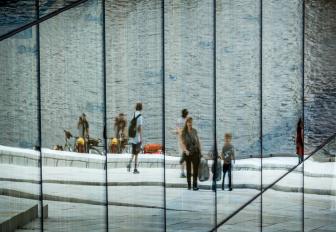The Mystique Remains
The World According To Daniel Morduchowicz
"It is impossible for
anyone to go out and photograph something and not have it reflect who
they are. It's almost intangible. You can analyze and say it's
the cropping or it's the lens, but the mystique remains." There is nothing mainstream in the images of Daniel Morduchowicz. He is not interested in common themes or reality, as most of us know it. Shutterbug caught up with Morduchowicz at PhotoPlus Expo 2003 at the Javits Center in New York, where his work was prominently displayed at the MediaStreet, Inc. booth. |
||||
Attracted by a group of portraits
exhibited along the wall of the booth, I approached to find that these
were not images of live models but rather strange and spooky mannequins
posed as if to show another side of our own persona, an interpretation
of who we think we might like to be--perfect bodies, makeup, style--symbols
of beauty. It is easy to understand these as an art form, but the more
I looked, the harder it was not to make a connection with the images.
|
||||
Computer Tech Lasting Images |
||||
A Light Photoshop
Touch Simple Gear |







































